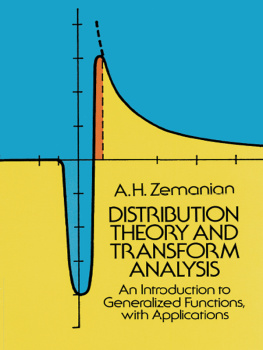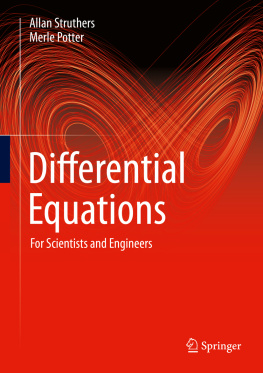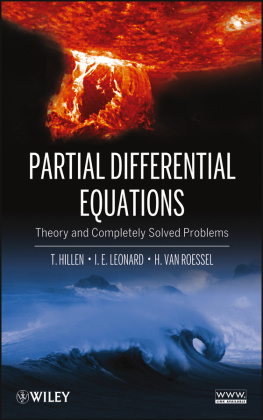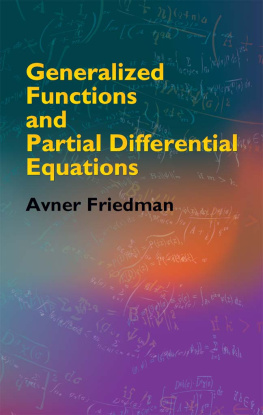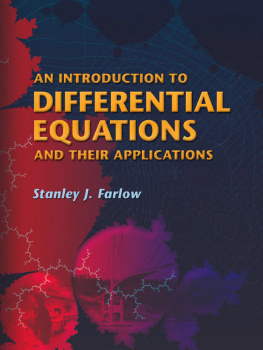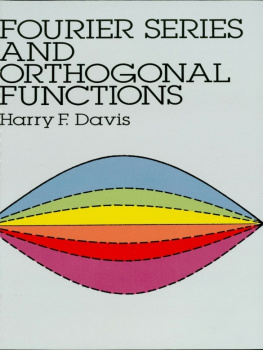Distribution Theory and Transform Analysis
An Introduction to Generalized Functions, with Applications
by A. H. Zemanian
College of Engineering and Applied Sciences
State University of New York
at Stony Brook
DOVER PUBLICATIONS, INC.
New York
To Edna
Copyright 1965 by A. H. Zemanian.
All rights reserved.
This Dover edition, first published in 1987, is an unabridged, slightly corrected republication of the work first published by the McGraw-Hill Book Company, New York, 1965, in its International Series in Pure and Applied Mathematics.
Library of Congress Cataloging-in-Publication Data
Zemanian, A. H. (Armen H.)
Distribution theory and transform analysis.
Reprint, slightly corrected. Originally published: New York : McGraw-Hill, Ci965. (International series in pure and applied mathematics)
Bibliography: p.
Includes index.
1. Distributions, Theory of (Functional analysis) 2. Transformations (Mathematics) I. Title.
QA324.Z46 1987 515.782 87-9116
eISBN-13: 978-0-486-15194-6
Manufactured in the United States by Courier Corporation
65479609 2014
www.doverpublications.com
Preface
L. Schwartzs theory of distributions had two important effects in mathematical analysis. First of all, it provided a rigorous justification for a number of formal manipulations that had become quite common in the technical literature. The second and more important effect was that it opened up a new area of mathematical research, which in turn provided an impetus in the development of a number of mathematical disciplines, such as ordinary and partial differential equations, operational calculus, transformation theory, and functional analysis. However, the subject has remained pretty much in the realm of advanced mathematics, and only a few aspects of it have found their way into the technical literature.
To be sure, a certain type of distribution (in particular, the delta function and its derivatives) had been used in the physical and engineering sciences for quite some time before the advent of distribution theory. Indeed, the delta function dates back to the nineteenth century. A summary of its history is given by Van der Pol and Bremmer (see ), who used it to generalize the Fourier transformation for functions f(t) that grow as some power of t as |t| approaches infinity.
This book, which is based on a graduate course given at the State University of New York at Stony Brook, has two objectives. The first is to provide a comparatively elementary introduction to distribution theory, and the second is to describe the generalized Fourier and Laplace transformations and their applications to integrodifferential equations, difference equations, and passive systems. In recent j^ears an ever-increasing number of textbooks have been devoted to the classical Fourier and Laplace transformations. The corresponding distributional transformations, although they are considerably more powerful tools, have not received the same attention in the current textbooks, nor have they been widely employed by scientists and engineers. It is hoped that this book will help to popularize distributional transform analysis.
Actually, one can introduce the delta function and its derivatives without developing a general theory of distributions, and many current books do so. However, these singular functions comprise but a very small subclass of all the distributions. More importantly, distribution theory provides powerful analytical techniques that cannot be described merely in terms of the delta function and its derivatives. An account of some of these techniques is given in this book.
Another theory of generalized functions is provided by Mikusiskls operational calculus (see we very briefly discuss Mikusiskls operational calculus and compare it with distribution theory.
There are a variety of other approaches to the theory of generalized functions that are based, in general, on the facts that generalized functions can be represented as sequences of ordinary functions, which converge in a certain way, and that over a finite interval a generalized function is a finite-order derivative (in an unconventional sense) of a continuous function. (See, for example, generalized functions as certain continuous linear functionals, has become indispensable, in view of the large and ever-increasing body of literature that uses this point of view. For these reasons, our development will employ Schwartzs functional approach.
This book can be used for a graduate course for engineering and science students and possibly for a senior-level undergraduate course for mathematics majors. It is presumed that the reader has already had a course in advanced calculus and is familiar with the standard theorems on the interchange of limit processes. Some knowledge of functions of a complex variable and of matrix manipulations is also assumed. Finally, at certain places we employ some elements of the theory of Lebesgue integration, although most of the text can be followed without having any knowledge of this subject. In any case, whenever theorems or techniques in any of these subjects are used, the reader is referred to various standard books, where he can seek any additional information that he may need.
In ).
An attempt has been made to render all the proofs as elementary as possible. For example, can be proved in a very brief way if use is made of the Hahn-Banach theorem. This has not been done; instead, a longer but more elementary argument has been employed.
Since this book is addressed both to mathematics students and to science and engineering students, the problems have been designed to develop the readers understanding of the theory as well as his facility for using distributions. Thus, some of the problems are exercises of proof; they are concerned either with the arguments given in the text or with the extension of the theory and the development of new results. In contrast to this, other problems develop specific convolution and transform formulas. Still others are exercises for solving distributionally various differential and difference equations; they are intended to enlarge the students ability to apply distribution theory. It is hoped that a sufficiently broad spectrum of problems has been provided to satisfy the diverse needs of various types of students.
Briefly, the structure of this book is as follows. In .
are concerned with the convolution process and its use in representing differential and difference equations.
The distributional Fourier and Laplace transformations are developed in to obtain an operational calculus for the solution of differential and difference equations of the initial-condition type.
Some of the previous theory is applied in to a discussion of the fundamental properties of certain physical systems, and a concise development of the relationship between the positive-reality of a system function and the passivity of the system is obtained there.
ends the book with a consideration of periodic distributions. This chapter acts in a crude way as a summary of the book, since it follows the broad outline of the preceding portion of the text.
The appendixes contain a table of formulas for the distributional Laplace transformation, a glossary of symbols, and a bibliography. We particularly direct the readers attention to , which contains the definitions of most of the symbols used in the text.
There is enough material in this book for a two-semester course. A one-semester course may be based upon the following portions of the text: Sees. reader may at first skip these proofs and just read the theorems, examples, and explanatory portions of the diamond-marked sections. This will provide a still briefer introduction to distribution theory without any loss of continuity.
Next page
